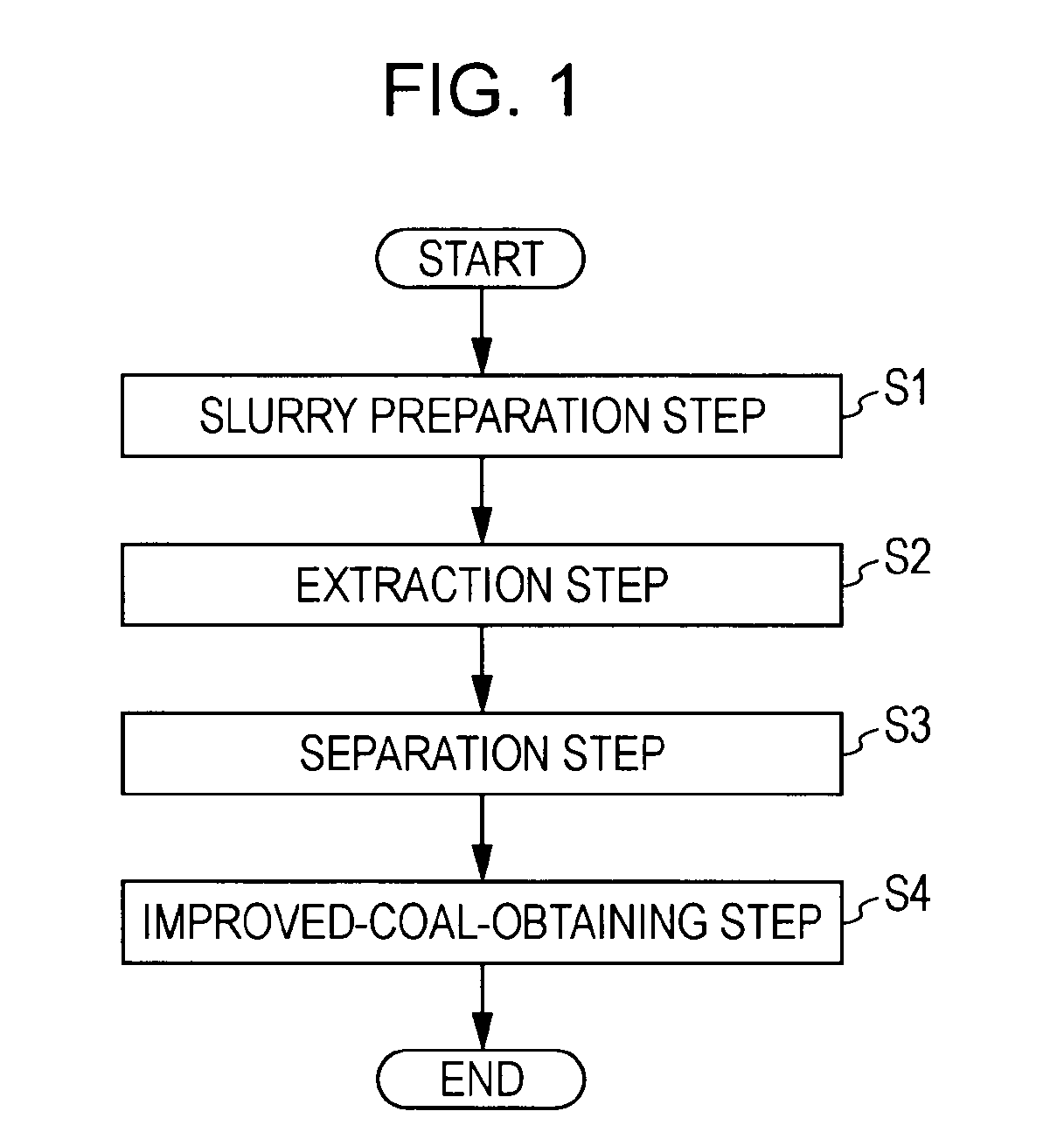Method of producing ashless coal
a technology of ashless coal and ash-free coal, which is applied in the production of liquid hydrocarbon mixtures, solid fuels, petroleum industry, etc., can solve the problems of insufficient caking coal resource and high cost of caking coal, and achieve the effects of low cost, high production efficiency and improved thermal plasticity of the resultant blended coal
- Summary
- Abstract
- Description
- Claims
- Application Information
AI Technical Summary
Benefits of technology
Problems solved by technology
Method used
Image
Examples
example 1
[0090]In Example 1, in the case where an extraction temperature in an extraction step was 370° C., changes in thermal plasticity (softening fluidity), a resolidification temperature, and the like of raw coal samples and ashless coal samples obtained from the raw coal samples were examined (Experimental Example 1).
[0091]Strongly caking coal A, strongly caking coal B, and sub-bituminous coal C having industrial analysis values and elemental analysis values shown in Table 1 were used as raw coal samples. Five kilograms of each of the raw coal samples was mixed with 20 kg (fourfold) of a solvent (1-methylnaphthalene (produced by Nippon Steel Chemical Co., Ltd.) to prepare slurries. Extraction was performed by pressing each of the slurries with nitrogen at a pressure of 1.2 MPa in an autoclave having an internal volume of 30 L at 370° C. for one hour. Each of the slurries was separated into a supernatant and a solid-concentrated liquid in a gravity settling chamber in which the same temp...
example 2
[0101]In Example 2, the relationship between the extraction temperature when an extraction treatment of the sub-bituminous coal C used in Example 1 was performed and the resolidification temperature of the ashless coal c obtained from the sub-bituminous coal C was examined (Experimental Example 2).
[0102]FIG. 4 shows the relationship between the extraction temperature and the resolidification temperature of the prepared ashless coal c in the case where an extraction treatment was performed with an extraction time of one hour (60 minutes) using the sub-bituminous coal C was used as raw coal.
[0103]The method of producing ashless coal was performed in accordance with Example 1 except that the extraction temperature was changed.
[0104]As shown in FIG. 4, at extraction temperatures exceeding about 360° C., as the extraction temperature increased, the resolidification temperature of the ashless coal c increased. At an extraction temperature of 400° C., the resolidification temperature was a...
example 3
[0106]In Example 3, the relationships between the extraction temperature, the extraction time, and the extraction yield in the case where an extraction treatment of the sub-bituminous coal C used in Example 1 was performed were examined (Experimental Example 3).
[0107]FIG. 5 shows the relationship between the extraction time and the extraction yield in the case where the sub-bituminous coal C was heated to an extraction temperature of 370° C., 400° C., or 420° C. with a preheater, and kept in an extractor for a predetermined time, and then rapidly cooled to 360° C. to perform an extraction treatment. In the experiment at 420° C., the time required for increasing the temperature from 400° C. to 420° C. in the preheater was eight minutes. Accordingly, in FIG. 5, extraction times which also include the eight minutes, which corresponds to an extraction time from 400° C. to 420° C., in the preheater are shown.
[0108]The method of producing ashless coal was performed in accordance with Exam...
PUM
| Property | Measurement | Unit |
|---|---|---|
| temperature | aaaaa | aaaaa |
| temperature | aaaaa | aaaaa |
| temperature | aaaaa | aaaaa |
Abstract
Description
Claims
Application Information
 Login to View More
Login to View More - R&D
- Intellectual Property
- Life Sciences
- Materials
- Tech Scout
- Unparalleled Data Quality
- Higher Quality Content
- 60% Fewer Hallucinations
Browse by: Latest US Patents, China's latest patents, Technical Efficacy Thesaurus, Application Domain, Technology Topic, Popular Technical Reports.
© 2025 PatSnap. All rights reserved.Legal|Privacy policy|Modern Slavery Act Transparency Statement|Sitemap|About US| Contact US: help@patsnap.com



